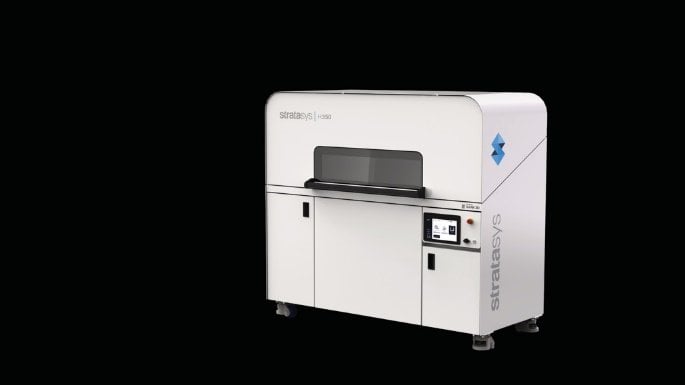www.ptreview.co.uk
29
'21
Written on Modified on
STRATASYS INTRODUCES H350 3D PRINTER FOR PRODUCTION-SCALE ADDITIVE MANUFACTURING
Powered by SAF technology, the H350 printer is designed to deliver consistent, accurate, production-grade parts with affordable and predictable costs compared to traditional manufacturing or competing for 3D printers.

Stratasys Ltd. (NASDAQ: SSYS), a leader in polymer 3D printing solutions, today introduced the Stratasys H350 3D printer, designed specifically for end-use parts production. Powered by SAF technology, the new H350 printer is designed to give manufacturers production consistency, a competitive and predictable cost per part, and complete production control for volumes of thousands of parts. The H350 printer even includes a dozen different parts 3D-printed with SAF technology.
The printer is expected to commence shipping in Q3 of 2021, and parts printed on the H350 are available today in limited quantities via Stratasys Direct Manufacturing.
Powered by SAF technology, the new H350 printer is designed to give manufacturers production consistency, a competitive and predictable cost per part, and complete production control for volumes of thousands of parts “We see production-scale 3D printing transforming manufacturing in industries around the world as companies seek to move with more agility and efficiency,” said Omer Krieger, Stratasys’ executive vice president of product strategy and corporate development. “We believe the H350 and SAF technology will stand out compared to traditional manufacturing methods and alternative 3D printing solutions when you need reliable and repeatable production at volumes of several thousand parts and with compelling economics.”
Stratasys shared details about SAF technology in March. The industrial-grade additive manufacturing technology executes key 3D printing steps in the same direction across the print bed to provide a uniform thermal experience – and therefore part consistency – for all printed parts regardless of their placement in the build. SAF can also contribute to lower operational costs and increase their predictability. For example, the Big Wave powder management system reduces powder aging, while the warranty-protected industrial piezo-electric print heads have been designed to require no regular replacement.
Circuit board housing and bracket 3D printed with the Stratasys H350 3D printer. Traditional manufacturing would require several separate pieces to be produced and assembled together. Additive manufacturing with the H350 enables it to be produced as a single partThe H350 is designed to meet the needs of customers in industries such as commercial goods, automotive, and consumer goods and electronics that benefit from the ability to quickly produce large volumes of 3D-printed parts with compelling and predictable economics. Service bureaus and contract manufacturers also benefit from the industrial-grade performance of the system. Applications include end-use parts such as covers, connectors, hinges, cable holders, electronics housing, and ducting. Goetz Maschinenbau, a Germany-based service bureau providing on-demand parts, is beta-testing an H350 3D printer (see video here). The company provides a variety of automotive, consumer goods, and medical industry customers with end-use plastic parts, and already owns Stratasys FDM and PolyJet systems. Adding a new SAF-based 3D printer is a significant growth opportunity for the company, as it expands beyond CNC machining for end-use parts.
“We have ambitious plans to grow our business and we believe adding a Stratasys H350 will be a key component of that growth,” said Owner Philipp Goetz. “We have fulfilled orders for both large parts as well as up to several hundred smaller parts. We have been impressed with the performance of the system and SAF technology, with consistent parts throughout the build volume. The system has also been impressively reliable.”
The H350 provides several control features designed to ensure the system is production-ready for companies ready to embrace additive manufacturing at scale. All build data is logged for process traceability and remains fully under the customer’s control. Materials can be controlled, tracked and traced, and print-settings can be fine-tuned for each customer’s needs.
Part Packing Density
The architecture of SAF technology enables part packing in the volume to a standard density of up to 12%, compared to the 6-10% density that is more typical for powder bed fusion 3D printers. Moreover, Stratasys has been able to demonstrate support for packing densities of up to 23.5% in real-world conditions. Packing density directly translates into either more parts per build or a faster build time.
Material
For the H Series Production Platform, Stratasys is using certified third-party materials. The initial material for the H350 is Stratasys High Yield PA11, which is a bio-based plastic made of renewable raw materials derived from sustainable castor oil. Compared to PA12, PA11 has a lower environmental impact, has superior thermal resistance and is less brittle. It has passed initial tests including ISO 10993-5 for cytotoxicity and UL94 HB for flammability. Stratasys ultimately plans to support a wide range of certified polymer materials, supported by the versatility of SAF technology.
Software
Recognizing the importance of enterprise connectivity for production scale and efficiency, H350 customers will be able to integrate with manufacturing floor systems through the MT Connect standard. Customers will also be able to utilize software applications such as Materialise’s Magics, Siemens NX, and PTC Creo with Stratasys Build Processor. Stratasys will also provide GrabCAD Print support in the future for build preparation.
www.stratasys.com

